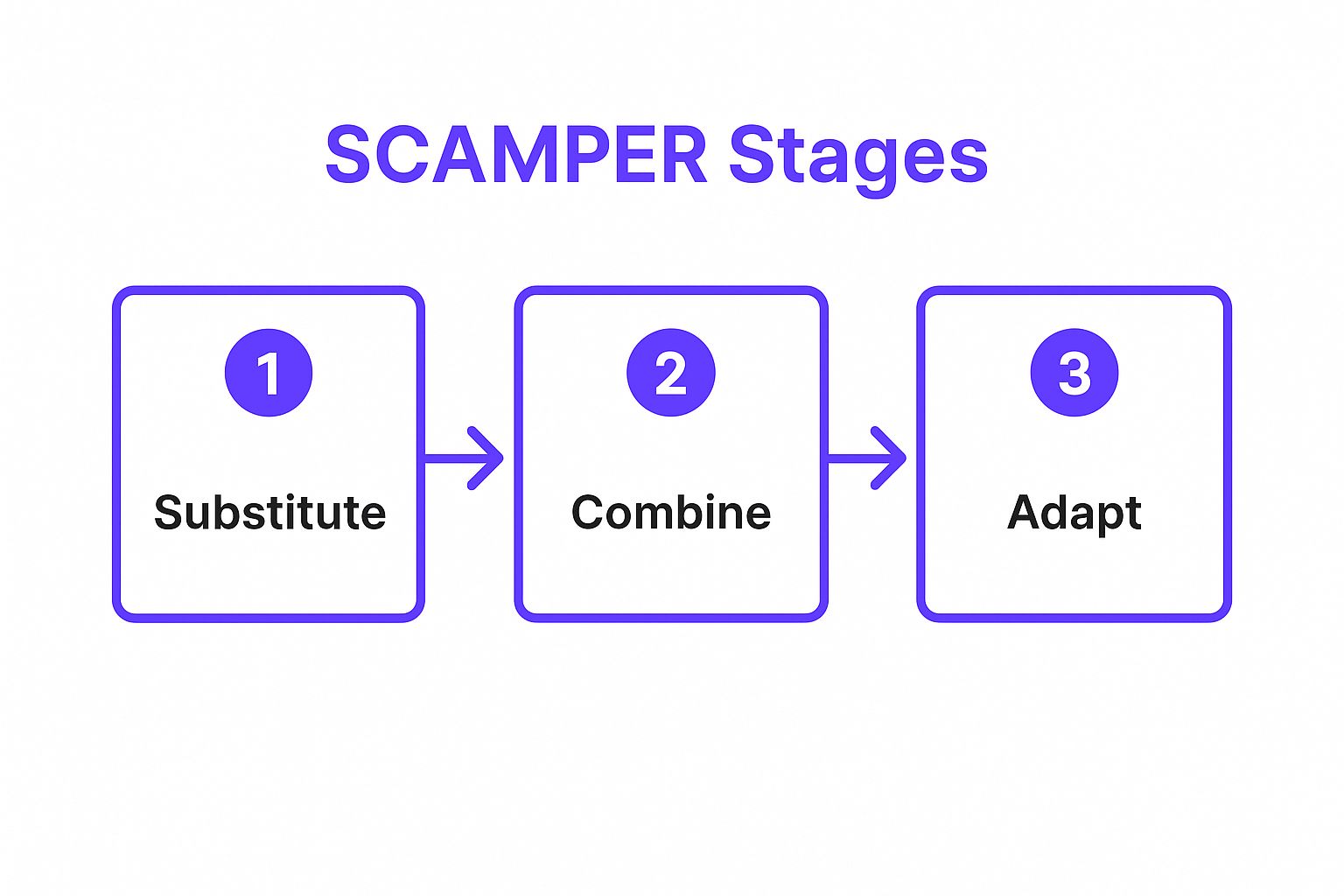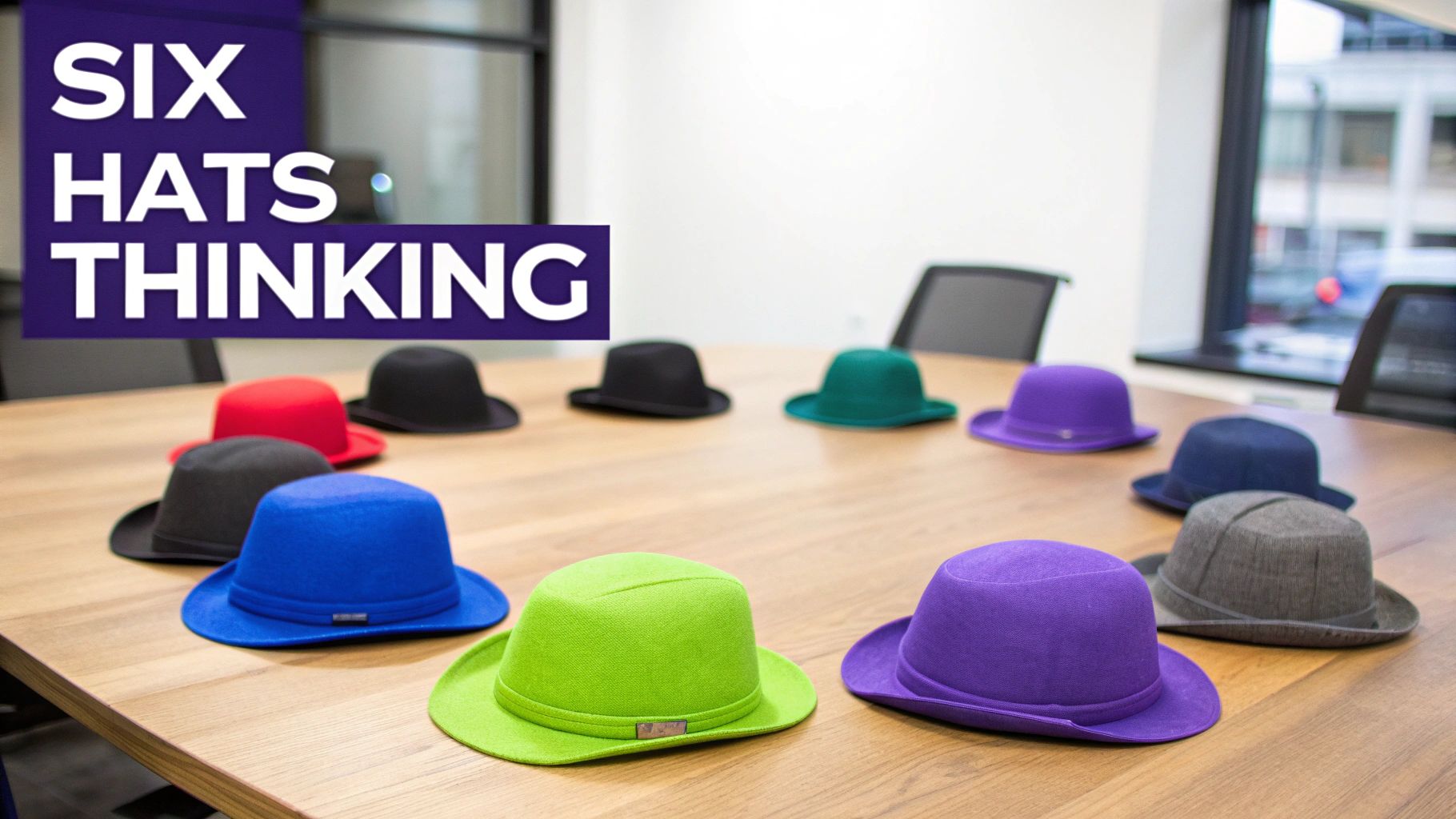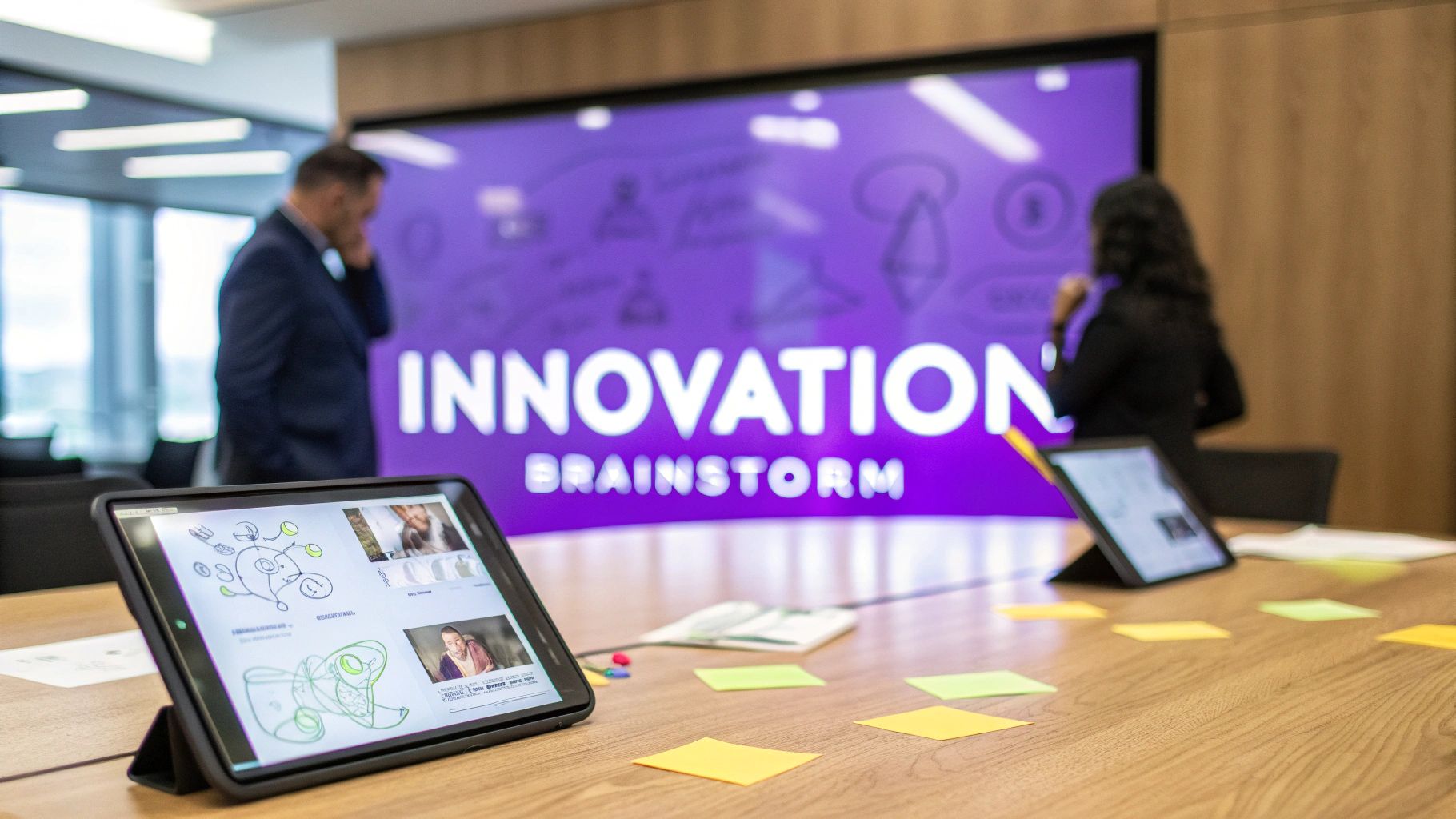In today's fast-paced world, relying on the same old 'let's just throw ideas at a wall' approach to brainstorming is a recipe for stagnation. True innovation requires structure, diverse perspectives, and methods designed to overcome the common pitfalls of groupthink and creative blocks. For remote and hybrid teams, the challenge is even greater. In today's remote-first world, many old brainstorming methods fall flat. Discover how to run a virtual brainstorming session that actually works and adapt your strategy.
The answer lies in adopting structured innovation brainstorming techniques. These aren't just abstract theories; they are battle-tested frameworks that guide teams from problem to breakthrough solution. This article breaks down eight of the most powerful techniques, including SCAMPER, Reverse Brainstorming, and the 6-3-5 Brainwriting method.
We will provide actionable steps, best practices, and specific tips for remote implementation for each one. You'll learn how these methods can transform your ideation sessions from unproductive meetings into powerful engines for growth and innovation, ensuring every voice is heard and every idea is explored. For teams looking to streamline this process, tools like Bulby offer a guided, AI-powered platform that embeds these proven techniques directly into your remote workflow, making structured creativity more accessible than ever.
1. Mind Mapping
Mind mapping is a powerful visual brainstorming technique used to explore, organize, and connect ideas. It begins with a single, central concept, and from there, related ideas branch out like a tree. This structure mirrors the way our brains naturally make associations, making it one of the most intuitive innovation brainstorming techniques for both individual and group ideation. It allows teams to see the big picture and the intricate details simultaneously, fostering a holistic understanding of a problem or concept.

This method, popularized by author Tony Buzan, is highly effective for breaking down complex challenges into manageable parts. For instance, Disney has famously used mind mapping to develop intricate storylines and characters, while Boeing applied it to solve complex engineering and design problems. The visual nature of a mind map helps uncover hidden connections and stimulates creative thinking by engaging both the logical and artistic sides of the brain.
How to Implement Mind Mapping
- Define the Core Idea: Start by writing your central topic or problem statement in the middle of your whiteboard, digital canvas, or paper. This is your trunk.
- Create Main Branches: Draw branches outward from the central idea. Each branch represents a primary theme or category related to your topic. Label these with a single keyword or a short phrase.
- Add Sub-Branches: From your main branches, draw smaller, secondary branches to add more detailed ideas, tasks, or questions. Continue branching out as more ideas emerge.
- Use Visual Cues: Enhance your map with colors, symbols, and images. Assigning different colors to major branches helps categorize information and makes the map easier to read and remember.
Key Insight: The non-linear format of mind mapping liberates you from the constraints of traditional, list-based brainstorming. This freedom encourages a more natural flow of ideas, which is essential for true innovation.
Best Practices for Remote Teams
For distributed teams, digital mind mapping tools like MindMeister or XMind are invaluable. They allow for real-time, synchronous collaboration where every team member can add to the map simultaneously. This ensures everyone feels engaged and can contribute equally, regardless of their location.
To make your virtual session a success, share a template beforehand and establish clear color-coding rules. For a deeper dive into applying this technique, you can explore more resources on brainstorming and mind mapping.
2. SCAMPER Technique
SCAMPER is a structured brainstorming method that uses seven creative thinking prompts to generate innovative ideas. By examining existing products or concepts from different angles, it forces you to think outside the box. This method is one of the most systematic innovation brainstorming techniques, providing a clear checklist to guide creative problem-solving and ensure all avenues are explored.
SCAMPER is an acronym for Substitute, Combine, Adapt, Modify, Put to another use, Eliminate, and Reverse. For instance, Apple effectively used these principles to create the iPhone by Combining a phone, an iPod, and an internet device. Similarly, Uber Adapted the traditional taxi model by substituting a physical dispatch system with an intuitive app-based technology. This structured approach helps teams methodically deconstruct a problem and reconstruct it into an innovative solution. Many innovation brainstorming techniques, like SCAMPER, fundamentally rely on asking the right questions to spark creativity. Mastering how to ask better questions can unlock deeper insights and more innovative solutions.
How to Implement the SCAMPER Technique
- Select a Focus: Choose an existing product, service, or process you want to improve or innovate. This will be the subject of your SCAMPER session.
- Go Through the Checklist: Systematically ask questions related to each of the seven SCAMPER prompts. For example, for 'Substitute,' you might ask, "What materials or components can we substitute to improve this product?"
- Generate Ideas: Encourage the team to brainstorm answers to each question without judgment. Capture every idea, no matter how unconventional it may seem.
- Evaluate and Refine: Once you have a list of ideas for each prompt, review and evaluate them based on feasibility, potential impact, and alignment with your goals.
Key Insight: SCAMPER provides a structured framework that prevents brainstorming sessions from becoming too chaotic or unfocused. Its question-based approach systematically pushes creative boundaries, making it ideal for incremental and disruptive innovation.
This process flow visualizes the first three stages of the SCAMPER method, illustrating how ideas can be transformed sequentially.

The diagram highlights the logical progression from substituting elements to combining features and adapting concepts for new contexts.
Best Practices for Remote Teams
SCAMPER works exceptionally well for remote teams when using collaborative digital whiteboards like Miro or Mural. Create seven distinct columns or frames on the board, one for each letter of the acronym. Team members can then add their ideas on digital sticky notes within the appropriate column, allowing for parallel, asynchronous, or synchronous ideation.
To maximize engagement, assign a different team member to facilitate each letter of the SCAMPER framework. This shared ownership keeps the energy high and ensures diverse perspectives are heard. For a deeper look at similar methods, explore these creative thinking exercises for groups.
3. Six Thinking Hats
Six Thinking Hats is a parallel thinking method that systematically directs focus and conversation. Developed by Edward de Bono, this technique assigns six colored "hats," each representing a different mode of thinking. By having the entire group "wear" the same hat at the same time, teams can explore a problem from multiple perspectives without conflict, ensuring all angles are considered. This structured approach is one of the most effective innovation brainstorming techniques because it separates ego from performance and encourages a more comprehensive, collaborative analysis.

This method moves teams beyond their default thinking styles, preventing common brainstorming pitfalls like premature criticism or unchecked optimism. For example, IBM has used Six Thinking Hats for more efficient strategic planning and product development, while Prudential Insurance applies it to assess risks and drive innovation projects. The technique ensures that emotional, logical, creative, and critical viewpoints are all given equal weight, leading to more balanced and well-rounded decisions.
How to Implement Six Thinking Hats
- Introduce the Hats: Explain the role of each colored hat to the team. White (facts), Red (emotions/intuition), Black (cautions/risks), Yellow (benefits/optimism), Green (creativity/new ideas), and Blue (process/organization).
- Set the Agenda: The facilitator (wearing the Blue Hat) defines the problem and proposes a sequence for the hats. A common sequence is Blue, White, Green, Yellow, Black, Red, and finally Blue again for a summary.
- Wear One Hat at a Time: The entire group focuses on one perspective simultaneously. For instance, during the Green Hat phase, everyone contributes creative ideas without judgment.
- Time Each Hat: Allocate a specific amount of time for each hat (e.g., 2-5 minutes) to maintain focus and momentum. The facilitator keeps track and guides the transition to the next hat.
Key Insight: The power of Six Thinking Hats lies in its ability to de-personalize criticism and discussion. When everyone is wearing the Black Hat, a critical comment is seen as fulfilling a role, not as a personal attack.
Best Practices for Remote Teams
This technique adapts exceptionally well to virtual settings. Use digital whiteboard tools like Miro or Mural to create dedicated sections for each hat. Team members can add digital sticky notes under the current "hat" in real-time.
To facilitate a remote session, use colored banners or virtual backgrounds to signify which hat is currently active. The structured, turn-based nature of the method ensures that everyone has a clear opportunity to contribute, preventing more vocal participants from dominating the conversation. For more on the official method, visit the de Bono Group website.
4. Reverse Brainstorming
Reverse brainstorming is a creative problem-solving method that flips traditional ideation on its head. Instead of asking, "How can we solve this problem?" you ask, "How could we cause or worsen this problem?" This counterintuitive approach is one of the most effective innovation brainstorming techniques for overcoming mental blocks and challenging ingrained assumptions. By intentionally focusing on the negative, teams can uncover hidden obstacles and root causes that might otherwise go unnoticed.
This technique is powerful because it encourages a playful and unrestricted flow of ideas, often revealing unconventional solutions when the negative ideas are reversed. For instance, safety engineers use reverse brainstorming to proactively identify potential system failures. Similarly, Netflix effectively applied this thinking by asking how to make a video rental service worse, leading them to eliminate late fees and physical stores, which became the core of their disruptive subscription model.
How to Implement Reverse Brainstorming
- Define the Problem: Clearly state the problem you are trying to solve. For example, "How can we improve customer satisfaction?"
- Reverse the Problem: Flip the problem statement into a negative one. For example, "How can we make our customers as unhappy as possible?"
- Brainstorm Negative Ideas: Generate as many ideas as possible to answer the reversed problem. Encourage wild and extreme suggestions, like "hide the customer support contact information" or "charge surprise fees."
- Reverse the Ideas into Solutions: Take each negative idea and reverse it to create a potential positive solution. For instance, "hide support info" becomes "make support highly visible and accessible," and "charge surprise fees" becomes "implement transparent, all-inclusive pricing."
- Evaluate and Refine: Analyze the new list of positive solutions to identify the most viable and impactful ideas to pursue.
Key Insight: The initial "negative" brainstorming phase lowers inhibitions and reduces the pressure to produce a "good" idea. This freedom allows teams to explore the problem space from a completely different angle, leading to breakthrough solutions.
Best Practices for Remote Teams
Reverse brainstorming works exceptionally well for remote teams using digital collaboration tools like Miro or Mural. A facilitator can set up two columns on a virtual whiteboard: one for "How to Make it Worse" and another for "How to Make it Better." Team members can anonymously add digital sticky notes to the first column, which helps ensure psychological safety and encourages more honest, radical ideas.
After the negative ideation phase, the team can collaboratively drag each negative idea to the second column and brainstorm its reversal. This visual and interactive process keeps everyone engaged and focused. To see how this fits into a larger ideation session, you can learn more about the complete brainstorming process steps.
5. Brainwriting (6-3-5 Method)
Brainwriting is a silent, structured brainstorming technique designed to generate a high volume of ideas while ensuring equal participation. The 6-3-5 variation is a powerful and efficient format where 6 participants write down 3 ideas each in 5-minute rounds, passing their papers to build on others' concepts. This method is one of the most productive innovation brainstorming techniques for eliminating groupthink and giving introverted team members a comfortable way to contribute their best ideas.

Developed by German marketing professor Bernd Rohrbach, this method systematically generates 108 ideas in just 30 minutes. Its genius lies in its parallel and silent nature, which prevents dominant voices from overshadowing others. Procter & Gamble has used brainwriting for new product development, while advertising agencies employ it to generate diverse campaign concepts without the initial bias of a creative director, fostering raw creativity.
How to Implement Brainwriting (6-3-5)
- Form Your Group: Gather a group of six participants and provide each person with a worksheet that has a grid for their ideas.
- First Round (5 Minutes): Each person silently writes down three initial ideas related to the problem statement in the top row of their worksheet. A strict time limit is crucial.
- Pass and Build: After five minutes, everyone passes their worksheet to the person on their right. In the next 5-minute round, each participant reads the ideas on the new sheet and adds three more ideas, which can be entirely new or build upon the ones already there.
- Repeat Until Complete: Continue this process for a total of six rounds. By the end, each worksheet will contain 18 ideas, resulting in a collective pool of 108 ideas.
Key Insight: The silent and individual nature of writing ideas before sharing removes performance anxiety and the fear of judgment. This structured process ensures that ideas are evaluated on their merit, not on who suggested them.
Best Practices for Remote Teams
For remote teams, brainwriting is easily adapted using digital tools. Shared documents like Google Docs or dedicated online whiteboards like Miro or Mural can host the process. Create a shared document with a table for each participant, and use a timer to signal when to move to the next person's section.
To ensure success, set up the document or board in advance and provide crystal-clear instructions. After the silent ideation phase, schedule a follow-up meeting to discuss, cluster, and vote on the generated ideas to identify the most promising concepts for further development.
6. Nominal Group Technique
The Nominal Group Technique (NGT) is a structured brainstorming method that equalizes participation and minimizes the influence of dominant personalities. It begins with silent, individual idea generation, followed by a round-robin sharing session where ideas are collected without debate. This ensures every voice is heard before the group moves to a discussion and, ultimately, a ranked-voting process to prioritize the best concepts. This structured approach is one of the most effective innovation brainstorming techniques for achieving consensus and objective decision-making.
Developed in 1968 by Andre Delbecq and Andrew Van de Ven, NGT is particularly valuable in situations where group dynamics might otherwise stifle creativity. For instance, healthcare organizations use it to develop and prioritize clinical protocols by gathering input from diverse medical professionals. Similarly, government agencies employ NGT for fair policy prioritization, ensuring that decisions are based on collective judgment rather than political pressure.
How to Implement Nominal Group Technique
- Silent Idea Generation: The facilitator presents a clear question or problem. Each participant silently brainstorms and writes down their ideas on paper or a digital document.
- Round-Robin Sharing: Each person shares one idea at a time, moving around the group. The facilitator records each idea on a shared board for all to see, without any immediate discussion or critique.
- Group Clarification: Once all ideas are listed, the group discusses each one to ensure everyone has a shared understanding. This phase is for clarification, not debate.
- Voting and Ranking: Participants privately rank or vote on the ideas. The votes are tallied to create a prioritized list, revealing the group's collective preference.
Key Insight: The "nominal" aspect (working in name only as a group during the idea generation phase) is its greatest strength. It prevents conformity and anchoring bias, allowing more novel and diverse ideas to surface before group influence takes over.
Best Practices for Remote Teams
Digital collaboration tools like Miro, Mural, or even shared documents are perfect for NGT with remote teams. Use virtual whiteboards to list ideas and anonymous polling features in platforms like Zoom or Slack for unbiased voting.
To ensure success, a strong facilitator is crucial for keeping the virtual session on track and managing time for each phase. For more guidance on this and similar methods, you can explore further resources on structured brainstorming methods.
7. TRIZ (Theory of Inventive Problem Solving)
TRIZ, a Russian acronym for the Theory of Inventive Problem Solving, is a systematic and data-driven methodology for innovation. It's built on the premise that inventive problems share common patterns, and that universal principles of invention can be applied to solve them. This approach moves beyond random idea generation, offering a structured framework for finding clever solutions to complex technical and business challenges. As a more analytical entry among innovation brainstorming techniques, TRIZ guides teams to resolve core contradictions rather than making compromises.
Developed by Soviet inventor Genrich Altshuller after analyzing millions of patents, TRIZ identifies predictable patterns of technological evolution. Companies like Samsung have used it for breakthrough product innovations, and Intel applies its principles to overcome semiconductor development challenges. This method is exceptionally powerful for engineering and product design teams aiming to solve deep-rooted problems with elegant, non-obvious solutions.
How to Implement TRIZ
- Define the Problem & Contradiction: Clearly articulate your problem in terms of a contradiction. For example, "We need our product to be stronger (improving parameter), but making it stronger adds weight (worsening parameter)."
- Identify the Inventive Principles: Use the TRIZ Contradiction Matrix to find the specific inventive principles recommended for resolving your identified contradiction. The matrix cross-references 39 engineering parameters.
- Brainstorm Solutions: Apply the suggested principles (e.g., "Segmentation," "Asymmetry," "Taking Out") to brainstorm concrete solutions. This focused approach generates targeted, high-potential ideas.
- Evaluate and Refine: Assess the generated solutions against your original problem and constraints. Select the most promising concept and develop it further.
Key Insight: TRIZ’s core strength lies in its ability to resolve contradictions, not just balance them. It forces teams to find an "ideal" solution where a desired feature is achieved without a corresponding negative trade-off.
Best Practices for Remote Teams
For distributed teams, TRIZ can be facilitated using digital collaboration tools and specialized software like Ideation-TRIZ or Innovation Workbench. These platforms often include databases of inventive principles and effects to guide the process.
To run a successful session, a trained facilitator is highly recommended. They can guide the team through defining contradictions and applying the principles correctly. Share preparatory materials about the specific TRIZ tools you plan to use, ensuring everyone understands the structured approach before the session begins. For a deeper understanding, teams can explore resources from the Altshuller Institute for TRIZ Studies.
8. Morphological Analysis
Morphological analysis is a systematic method for exploring every possible solution to a complex, multi-dimensional problem. It works by breaking down a challenge into its fundamental parameters and then examining all potential combinations of these parts. This structured approach is one of the most exhaustive innovation brainstorming techniques, ensuring no stone is left unturned and often revealing unexpected, highly creative solutions that might otherwise be missed.
This technique was developed by Swiss astronomer Fritz Zwicky to solve astrophysical problems, and its power lies in its ability to map out a complete "solution space." For example, the aerospace industry uses it to explore spacecraft design alternatives, and automotive companies apply it to generate new vehicle configurations. It forces teams to think beyond their usual assumptions and consider every permutation, making it ideal for problems where novel combinations are key to a breakthrough.
How to Implement Morphological Analysis
- Define the Problem: Clearly state the problem you need to solve. For instance, "Create a new type of urban transportation."
- Identify Key Parameters: List the core attributes or functions of the problem. For the transportation example, parameters could be Power Source, Capacity, Infrastructure, and Speed.
- List Variations for Each Parameter: Brainstorm all possible values or "states" for each parameter. For Power Source, variations could be Electric, Solar, Human-Powered, or Hybrid.
- Create a Matrix: Build a grid or "morphological box" with parameters as column headers and their variations listed below.
- Explore Combinations: Systematically combine one variation from each parameter column to generate new potential solutions. A combination might be Solar + Single-Person + Bike Lanes + Low Speed.
Key Insight: Morphological analysis turns creativity into a systematic process. By forcing you to consider all combinations, it helps overcome mental blocks and reveals innovative possibilities that intuition alone would overlook.
Best Practices for Remote Teams
Digital collaboration tools are perfect for morphological analysis. Use a shared spreadsheet (like Google Sheets) or a virtual whiteboard (like Miro) to build your matrix. Each team member can contribute variations to different parameter columns simultaneously, making the initial brainstorming phase highly efficient.
Assign columns to small groups to populate and then reconvene to review and explore the full matrix of combinations. For a deeper guide on setting this up with your team, you can learn more about morphological analysis on remotesparks.com.
Innovation Brainstorming Techniques Comparison
| Technique | Implementation Complexity 🔄 | Resource Requirements ⚡ | Expected Outcomes 📊 | Ideal Use Cases 💡 | Key Advantages ⭐ |
|---|---|---|---|---|---|
| Mind Mapping | Moderate (practice needed) | Low to Moderate (tools optional) | Enhanced idea connections and creative insight | Visual learners, complex problem analysis, brainstorming | Stimulates creativity, easy to modify, visual recall |
| SCAMPER Technique | Low to Moderate (structured prompts) | Low | Incremental innovations and solution improvements | Product development, process improvement | Clear guidance, easy to apply, systematic exploration |
| Six Thinking Hats | Moderate (facilitator recommended) | Low to Moderate | Balanced view, improved decision-making | Team decisions, conflict resolution | Considers multiple perspectives, reduces conflict |
| Reverse Brainstorming | Moderate (requires mindset shift) | Low | Unconventional solutions, uncover hidden assumptions | Overcoming blocks, challenging assumptions | Engages creativity through negative thinking |
| Brainwriting (6-3-5) | Moderate (structured, timed rounds) | Low to Moderate | Large quantity of ideas, documented contributions | Inclusive idea generation, introverted participants | Equal participation, reduces social pressure |
| Nominal Group Tech. | High (multi-phase process) | Moderate (facilitation required) | Prioritized ideas with group consensus | Group decision-making, prioritizing options | Prevents groupthink, combines individual & group input |
| TRIZ | High (complex methodology) | High (training/tools needed) | Systematic breakthrough innovations | Technical innovation, engineering contradictions | Proven inventive principles, reduces trial-and-error |
| Morphological Analysis | High (complex parameter setup) | Moderate to High | Comprehensive solution space coverage | Complex system design, exploring all solution combos | Ensures no options missed, reveals unexpected combos |
From Ideas to Impact: Putting Your Techniques into Action
You have now explored a powerful arsenal of eight distinct innovation brainstorming techniques, each designed to dismantle creative blocks and build a repeatable engine for generating groundbreaking ideas. From the visual, non-linear exploration of Mind Mapping to the structured, deconstructive approach of Reverse Brainstorming, you are no longer limited to simply "thinking harder." Instead, you have a toolkit to guide your team through any challenge with purpose and clarity.
The true value of these methods lies not in choosing one definitive "best" technique, but in understanding which tool to deploy for the right situation. The structured silence of Brainwriting can empower introverted team members in a remote setting, while the rigorous logic of TRIZ can help solve deeply entrenched technical problems that seem impossible at first glance. Mastering these frameworks transforms innovation from a lightning-in-a-bottle event into a reliable, manageable process.
Your Path from Theory to Practice
Moving forward, the key is consistent application. Don't let this knowledge remain theoretical. Your next step is to introduce one of these techniques into your team's next ideation session.
Here’s a simple action plan to get started:
- Identify a Current Challenge: Select a specific, well-defined problem your team is currently facing.
- Choose a Technique: Match a technique to the problem. Is it a process that needs improvement? Try Reverse Brainstorming. Do you need to ensure all voices are heard equally? Use the Nominal Group Technique.
- Brief Your Team: Clearly explain the rules and goals of the chosen method before the session begins. Setting expectations is crucial for success, especially with distributed teams.
- Debrief and Iterate: After the session, discuss what worked and what didn't. This feedback loop will help you refine your approach and build confidence in using these structured creative methods.
Ultimately, the goal is to cultivate a culture where structured ideation is the norm. It’s about building an environment where every individual, regardless of their role or location, feels equipped and empowered to contribute their most innovative ideas. This strategic approach to creativity is what separates industry leaders from the rest. As technology continues to evolve, these human-centric problem-solving skills become even more critical. Beyond these traditional methods, exploring new digital tools is also crucial. For instance, you can learn more about how Generative AI can empower creativity and significantly augment your team's brainstorming efforts.
By integrating these innovation brainstorming techniques into your workflow, you bridge the crucial gap between a fleeting idea and its real-world impact. You create a system that not only generates more ideas but, more importantly, generates better ones, consistently and on demand.
Ready to operationalize these techniques and supercharge your team's innovation pipeline? Bulby provides a dedicated platform that embeds these proven brainstorming frameworks with AI-powered guidance to facilitate more effective, inclusive, and impactful ideation sessions for remote and hybrid teams. Transform your brainstorming process from chaotic to systematic by visiting Bulby today.

